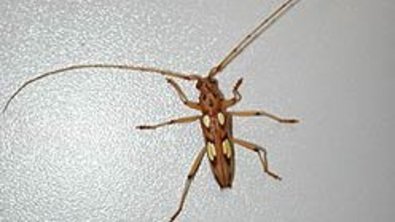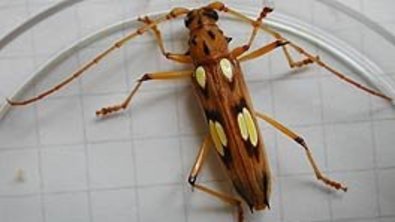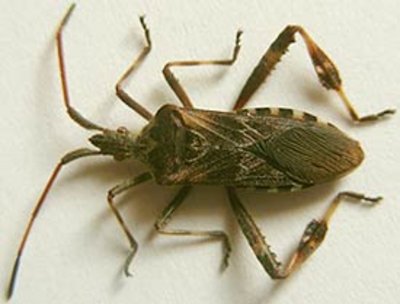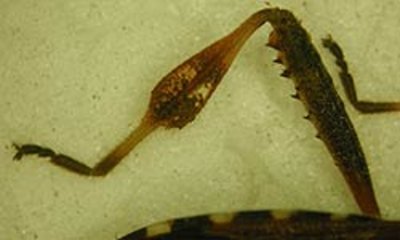In August 2007 the longhorn beetle Eburodacrys elegantula (Gounelle, 1909) was introduced to Vienna with liana for terraristic equipment. The beetle probably came from Brazil. It is not likely to spread in Austria due to climate conditions in winter. Already in 1999, the American Dock leaf bug Leptoglossus occidentalis (Heidemann, 1910) was found first in Europe (Italy), and in 2005 also in Austria. In autumn, many bugs were detected near buildings. Extreme weather conditions of the Austrian winter could not stop the spread of this species.
Longhorn Beetle Eburodacrys elegantula larvae imported in liana
In August 2007 the Department of Forest Protection, BFWwas notified by a reptile owner in Vienna, that she had heard a noise coming from the liana in the Terrarium of her Spiny Tail Lizard (Mountain Horned Dragon, Agamidae) and shortly after, a large insect had emerged, which she correctly identified as a Longhorn Beetle. The piece of liana (Figure 1) had been bought from an Austrian pet shop. Very often they originate in the tropics of South America and despite of the not inconsiderable quantity of imports, Plant Protection Laws do not prescribe import controls.

Figure 1: Probably South American liana as terraristic equipment with exit holes of beetles
Longhorn Beetle Eburodacrys elegantula larvae imported in liana
The piece of liana was handed over to the Forest Protection Department, where under quarantine laboratory conditions seven more of the same exotic Longhorn Beetles hatched over the following weeks. The identification of beetles from other continents, especially from South America, Africa, and Asia, can be difficult due to the many yet unknown species or incomplete identification literature. However, in this case with literature covering European and Asia Minor Longhorn Beetles it was possible at least to propose the following classification: they stem from the Eburiini beetles.
After further investigations on the internet, we conclude that the beetle could be classified in the genus Eburodacrys, and it is most likely to be Eburodacrys elegantula Gounelle, 1909 (Figure 2). Although the hind markings of the wing cases on the beetles are somewhat alternatively marked to the references, the entomology and specialist for Longhorn Beetles Steven Lingafelter (USDA, Smithsonian Institution, Washington, D.C.) could confirm this.This Longhorn Beetle species occurs in Bolivia, Ecuador, and Brasil (Lingafelter, pers. comm.; Martins et al. 2006; Wappes et al. 2007) and is found in a large range of regions with varying climate and habitat. The complete host range of tree/plant species is unknown. However, due to the winter extremes in Austria it is unlikely that it could survive under current natural climate conditions.

Figure 2a: Long horned beetle Eburodacrys elegantula, male

Figure 2a: Long horned beetle Eburodacrys elegantula, male
Western Conifer Seed Bug Leptoglossus occidentalis, recent in Austria

Figure 3: Dock leafbug Leptoglossus occidentalis

Figure 4: Typical for Leptoglossus occidentalis: Hind tibiae
with leaf-like expansions and hind femora with spines
Masses of large bugs were found in autumn 2007 near BFW Schönbrunn/Vienna. They were identified from the Leaf footed bug group as Leptoglossus occidentalis Heidemann, 1910. Although present in Europe since 1999, its presence in Middle Europe was recorded after having been found in Vienna, Carinthia, and Tyrol in autumn 2005 (Rabitsch und Heiss 2005), followed by Salzburg in 2006 (Nowotny 2007).
The 16 – 20 mm long bug is brownish in colour, whereby the mid section has a fine diagonal whitish marking (Figure 3). The upper-side of the abdomen ranges from yellow to yellow-orange, which is normally only visible during flight. A good identification method is the leaf shaped thickening of the back legs (Figure 4). Also, the teeth on the hind leg are clearly visible. Unlikemost of the related family the released stink ismore of apple scent in nature, and is not unpleasant.
The species was first described in California 1910, and, as previously mentioned, was found in Europe 1999 in Northern Italy. By 2001, it had populated a larger part of Lombardei and Veneto (Bernardinelli & zandigiacomo 2001). Before being detected in Austria 2005, it was present in Switzerland 2002, Spain 2003, Croatia and Hungary 2004. In 2006, it was found in Germany, France and in the Czech Republic. With its ability to fly, its spread and subsequent population of a region is almost inevitable. Its survival within our climatic conditions is enhanced, due to its overwintering strategy around the protected environments of buildings. Spread in varying larval development stages over long distances occurs through passive transportation of plant material.
The adult Leptoglossus occidentalis insect overwinters and draws nutrition from flowers and seeds in spring. The females lay their eggs on conifer needles, with main host plants being Pine species and Douglas fir. The young larvae feed primarily from
the developing cones, and occasionally needles. After the 5th larva stage they become adults, which can be expected from August onwards. In Europe, they have also been found on Picea, Abies, Cedrus and Juniperus.
In the United States it is considered a pest,that can affect the potential seed production from a stand, but otherwise there is no visual damage. It is not yet possible to evaluate the potential damage to Austrian forestry (e.g. at Douglas fir). A potential epidemic level is not expected. It is more likely that the bugs become an annoying factor within habituated buildings during their autumn search for an overwinter resting place.
References
- Bernadinelli, I., zandigiacomo, P. 2001: A conifer seed bug recently found in northern Italy: Leptoglossus occidentalis Heidemann (Heteroptera: Coreidae). j. For. Sci., 47, Special Issue 2: 56-58.
- Martins, U. R., Galileo, M. H. M., Santos-Silva, A., Rafael, j. A. 2006: Cerambycidae (Coleoptera) collected with light trap at 45 meters height over an Amazon forest canopy and the description of four new species. Acta Amazonica, 36(2): 265-272.
- Novotny, G. 2007: Erstnachweis der Amerikanischen Kiefernwanze in Salzburg – Ein Neozoon wurde in der Naturschutz-Abteilung vorstellig [First record of the American pine bug in Salzburg - a invasive species approaches the department of nature
conservation]. NaturLand Salzburg 2007 (1): 35-37. - Rabitsch, W., Heiss, E. 2005: Leptoglossus occidentalis Heidemann, 1910, eine amerikanische Adventivart auch in österreich aufgefunden (Heteroptera: Coreidae) [Leptoglossus occidentalis Heidemann, 1910, a American adventitious species also found in Austria (Heteroptera: Coreidae)]. Berichte des naturwissenschaftlich-medizinischen Vereins Innsbruck 92: 131-135.
- Wappes, j. E., Morris II, R. F., Nearns, E.H., Thomas, M. C. 2007: Preliminary Checklist of Bolivian Cerambycidae (Coleoptera)

